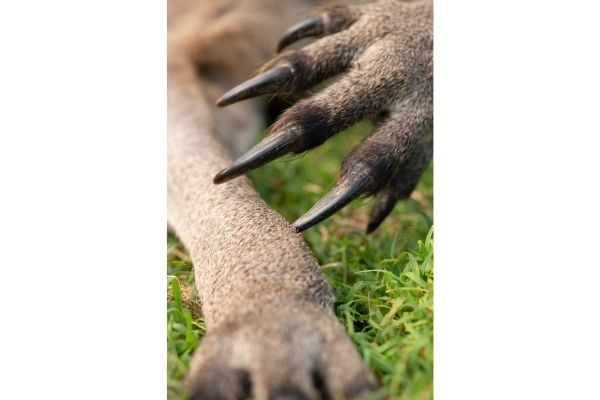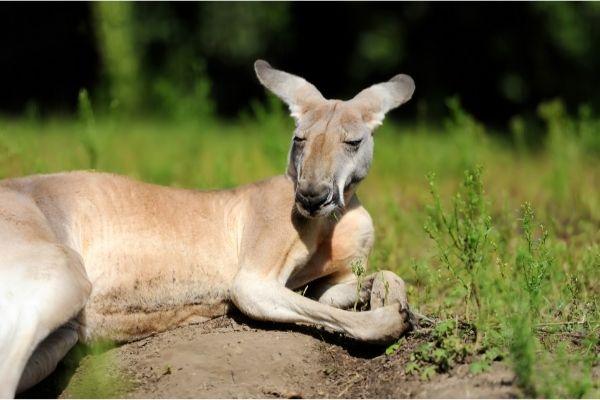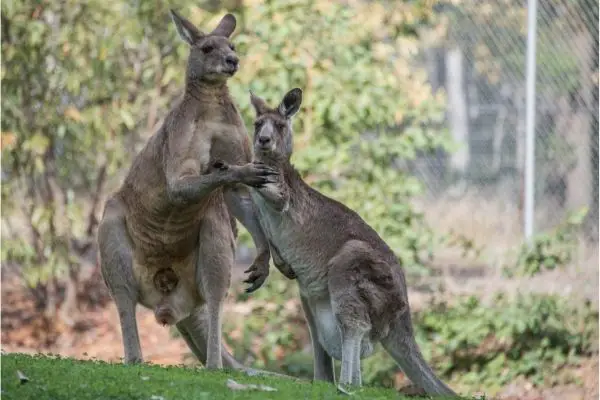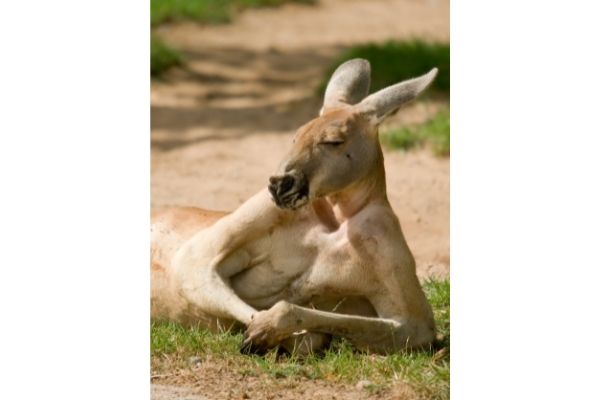Among all the animals in the world, Kangaroo has been of prime interest among the kids. Kids love Kangaroos and so do we. We have gathered a complete set of “Kangaroo Facts For Kids” which will help kids in learning all about Kangaroo. We have answered almost all the questions that might arise in the curious little minds. You are going to learn about Kangaroo’s physical description, physical characteristics, its body parts, scientific classification, the origin of kangaroos, its diet, habitat, life cycle, population, baby kangaroo facts, adaptations, and many more amazing, interesting, and weird facts about Kangaroos.
Kangaroo Facts For Kids
1. What Is A Kangaroo
- A kangaroo is a unique plant-eating marsupial that is only found in Australia and New Guinea. It has a long strong tail and powerful hind limbs that help it in leaping.
- Marsupials are those animals that carry their young ones in their natural pouch.
- Kangaroos are the biggest marsupials.
- Kangaroos have small heads and small front legs. They are herbivores and regurgitate their food like cows.
- Kangaroo is a national symbol of Australia and is part of the Australian “coat of arms” and some currencies.
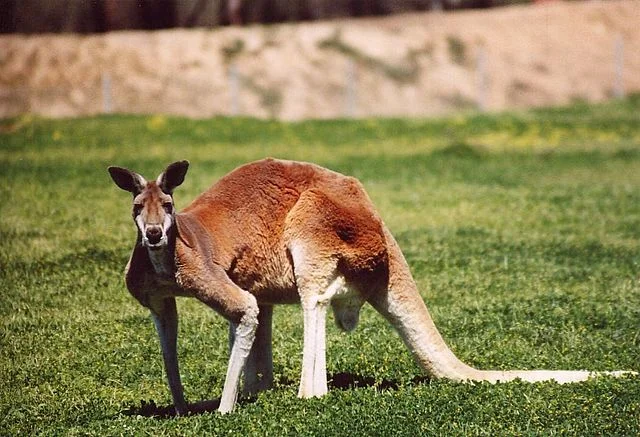
2. What Do Kangaroos Look Like – Kangaroo Description – Kangaroo Appearance
- Kangaroo is a large grazing animal similar in size to a deer. They have a nose and whiskers just like other grazing animals. Compared to their body size, their head is quite small but they have a long snout that helps them in grazing.
- Kangaroos have a strong back, muscular huge legs, and long back feet. Their front legs are small and more like arms but they do use them as legs. Kangaroos do not walk instead they hop.
- They occasionally stand in an upright position when they sense danger or when other kangaroos arrive.
- The female kangaroos have a pouch called a marsupium where they keep their young ones.
- Their tail is long, muscular, and very strong. It is used for balancing when they run.
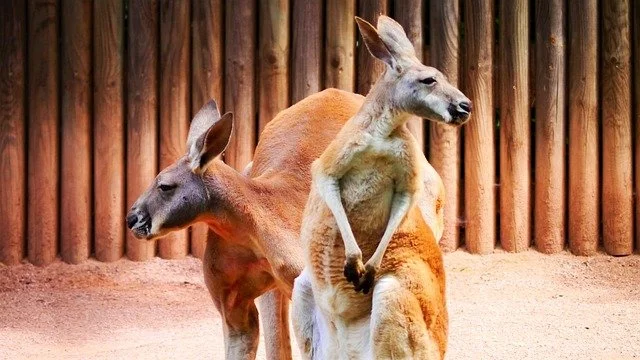
3. What Does Kangaroo Mean – Kangaroo Meaning
- It is believed that the word ‘kangaroo’ has been derived from gangurru (a word from the Guugu Yimithirr). Guugu Yimithirr was the first language of the people of the area.
- Sir. Joseph Banks first wrote the word “Kanguru” in his diary on 12 July 1770.
Another Name For Kangaroo
- Kangaroos are also known as “roos”.
- Male kangaroos are called bucks, boomers, jacks, or old men.
- Female kangaroos are called Doe, flyers, or jills.
- The younger kangaroos are known as joeys.
- When in groups they are known as mob, troop, or court collectively.
4. How Did The Kangaroo Get Its Name – Kangaroo Name Origin
- It is believed that a native was asked about the name of the creature ‘Kangaroo’, and the native answered: “I don’t know” in his language as ‘Kangaroo’, and so the creature was named as “Kangaroo”.
- The word “kan-ga-roo” is a word used for “I don’t know”.
- James Cook, a British explorer, is believed to be the one who asked the native about a kangaroo in 1770.
5. What Is The Scientific Name Of Kangaroo – Kangaroo Scientific Name
- There are four main species of kangaroos. Each one has a different scientific name. They are stated as below.
- ‘Red Kangaroo’, the scientific name of which is ‘Macropus rufus’.
- ‘Eastern grey kangaroo’, the scientific name of which is ‘macropus giganteus’
- ‘Western grey kangaroo’, the scientific name of which is ‘macropus fuliginosus’
- ‘Antilopine kangaroo’, the scientific name of which is ‘macropus antilopinus’
6. Kangaroo Classification – Kangaroo Taxonomy
| Kingdom | Animalia |
| Phylum | Chordata |
| Subphylum | Vertebrata |
| Class | Mammalia |
| Infraclass | Marsupialia |
| Order | Diprotodontia |
| Genus | Macropus |
| Subgenus | Macropus |
| Species | Macropus rufus (red kangaroo) Macropus giganteus (eastern grey kangaroo) Macropus fuliginosus (western grey kangaroo) Macropus antilopinus (antilopine kangaroo) |
7. Kangaroo Family
- Kangaroo belongs to the family ‘Macropodidae’. Macropods mean ‘large foot’.
- These animals are found in the Australian continent (the mainland, Tasmania, New Guinea, and nearby islands).
- Before 1788 A.D (European settlement in Australia) almost 65 species of Macropods existed. Many species became extinct gradually after 1788 A.D.
- Lagostrophinae and Macropodinae are the two subfamilies in the Macropodidae family.
- Lagostrophinae is represented only by a single species, banded hare-wallaby, while the rest of the species are part of the Macropodidae.
- The term ‘Kangaroo’ is used for the large members of the Macropodidae. Generally, the red kangaroo, antilopine kangaroo, eastern grey kangaroo, and western grey kangaroo are termed as ‘Kangaroo’.
8. What Type Of Animal Is A Kangaroo
- Kangaroo is a marsupial. It is a mammal and herbivore.
- Females have pouches that have mammary glands. The younger kangaroos are kept in the pouches until they can get out of the pouches.
- Kangaroos are social animals. They live in mobs and protect each other from dangers.
9. Are Kangaroos Mammals
- Yes, Kangaroos are mammals because they possess all the traits of mammals.
- They are warm-blooded vertebrates.
- The skin is covered with more or less hair.
- The mothers feed their children with milk. A female kangaroo can produce different milk having different nutrients. This causes survival of the different aged children.
10. Kangaroo History – Kangaroo Origin
- Didelphimorphia (The Opossum) is believed to be the oldest marsupial. From recent studies, it has been proved that today’s kangaroos have been evolved from a common Marsupial ancestor that belonged to South America.
- There are many theories regarding the origin and history of Kangaroos. The theories contradict whether the kangaroos migrated to South America from Australia or migrated to Australia from South America.
- It is believed that Kangaroo lived more than four million years.
11. How Big Do Kangaroos Get – Kangaroo Size
- The largest one among all Kangaroo species is the Red kangaroo having a height of 2.1m or 6.9 feet tall.
- The weight of the kangaroo was 91 kg or 201 lb.
- The length of the head to its trump was 1.6 m or 5.25 ft. Its tail further adds 110 centimeters or 43.5 inches.
12. How Tall Are Kangaroos – Kangaroo Height
- Different species of kangaroos have different heights.
- Male kangaroos are taller than female kangaroos.
Average Kangaroo Height
- An average red kangaroo’s height is 1.5 m or 4.9 feet.
- The height of a red kangaroo male is 1.4 m or 4.7 feet.
- The height of a red kangaroo female is 1.1 m or 3.6 feet.
- The average height of a grey kangaroo is 1.1m or 3.6 feet.
- Grey kangaroo male’s height is 1.3 m with tail equal to 1m
- Grey kangaroo female’s height is 1 m with tail equal to 0.84 m.
13. How Tall Can A Kangaroo Get
- They can get to a height of 2.1 m i.e. 6.9 feet.
- The average height of a male human is 6.1 feet so compared to us Kangaroos are taller than us.
14. How Much Does A Kangaroo Weigh – Kangaroo Weight
- Depending on species and gender, kangaroos have different weights.
- Red kangaroo males can weigh from 40 Kg to 90 Kg. Its maximum weight can reach 92 Kg.
- While Red kangaroo females can weigh from 18 to 40 Kg.
- Grey kangaroo male weighs almost 50 to 66 Kg.
- While female Grey kangaroo weighs from 17 to 40 Kg.
- Newborn baby kangaroo weighs about 0.8 grams.
Average Kangaroo Weight
- The average weight of a kangaroo is 55 Kg.
15. Biggest Kangaroo
- The biggest kangaroo confirmed till today was having a height of 2.1 m or 6.9 feet.
- It weighed 91 Kg or 201 lb.
- It was a red kangaroo with a strong and muscular body.
16. Kangaroo Body Parts
- Given below are the different body parts of a kangaroo:
- Ears: Kangaroos have two lengthy erect ears.
- Eyes: Kangaroo has two eyes. Eyes can have different colors like red, blue, grey, brown.
- Head: Kangaroos have a small head with a long snout.
- Arms: They have short arms.
- Hands: Kangaroos’ hands have claws.
- Feet: Kangaroos have long feet. Each foot is four-toed.
- Legs: kangaroos have powerful legs used for hoping.
- Tail: Kangaroo has a long, thick, and muscular tail.
- Pouch: Female kangaroos possess a pouch in the belly that possesses mammary glands.
- Skin: Kangaroos’ skin possesses fur of different colors depending upon species and gender.
17. Kangaroo Pouch Name
- The pouch is named ‘‘Marsupium”. Marsupium is a Latin word. Marsupium means ‘pouch’.
- The name marsupial (Family name) is derived from the Marsupium.
- Almost all the marsupials contain the pouch (Marsupium). The pouch contains mammary glands which produce milk. The younger kangaroos are fed the milk.
18. Kangaroo Pouch Facts
- Only the female kangaroos have a pouch or Marsupium at their bellies.
- The baby stays in the pouch for more than eight months till it is fully able to survive outside the pouch.
- The pouch contains mammary glands used for feeding the baby kangaroos.
- Joeys crawl to the pouch and take milk from the glands.
- The pouch is cleaned by the female kangaroo herself by licking.
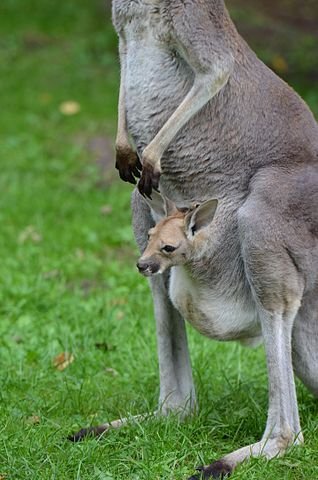
19. Male Kangaroo Pouch
- Male kangaroo doesn’t possess any pouch.
- The pouch is special to female kangaroos only.
20. Kangaroo Legs
- Kangaroo has two hind legs and two forelimbs.
- The hind legs are long and very powerful. They walk on the hind legs. The tail also helps in walking with two legs.
- The hind legs are used in hopping i.e making long jumps.
- The forelegs are very small almost 1/3 of the hind legs, while humans have arms of 2/3 length to legs.
- More often, the kangaroos use the forelegs as well for walking i.e using four legs.
- The forelegs can be regarded as arms of the kangaroos.
- Kangaroos fight by kicking the opponent with their legs.
21. Kangaroo Claws
Kangaroos have long narrow hind feet with four toes.
The second toe is large, strong, and has a massive claw.
The third and fourth toes are fused with the skin but they still have claws while the first claw has no primary use.
Kangaroos have short forelimbs having 5 toes on each front foot.
The toes have sharp claws.
They attack the opponent by standing on the hind legs and punching the opponent on the forelegs.
They are used for fighting, grasping, pulling down branches, and grooming purposes.
22. Kangaroo Foot And Paws
- Kangaroos belong to the group ‘Macropodidae’’ meaning ‘animal with big foot’.
- Kangaroos have large and heavy hind paws. Hind Legs are muscular and thick. The forepaws are small and light. The forelegs are relatively weak and short.
- Hopping is the primary means of Kangaroo’s movement.
- They use tails and forepaws for slow motion.
- They have five clawed and curved toes.
- They use the forepaws for grabbing and eating purposes.
- Kangaroos beat the ground through their hind paws in case of any danger, alarming other kangaroos.
- Kangaroo cannot move both hind feet independently.
How Many Legs Does A Kangaroo Have
- Kangaroos have four legs.
- Two forelegs and two hind legs.
- But sometimes tail is regarded as the ‘fifth foot of kangaroo‘. This is due to the reason that tail helps a lot in locomotion. It supports the weight of the kangaroo. While standing, the tail stabilizes the kangaroo. Kangaroos use the tail when they move slowly.
- The tail also helps when the kangaroo fights. The kangaroo stands on his tail while fighting. They use the forepaws to hold the opponent and with sharp hind claws, the kangaroo makes cuts on the opponent.
23. Kangaroo Special Features
- Kangaroo is well known for its ability to hop at high speed with powerful hind legs.
- It can cover a length of 30 feet in a single hop with a height of 10 feet.
- The tail which keeps the kangaroo in balance is a special feature.
- Kangaroo is special for its pouch, in which the newborn babies are kept and fed.
- Kangaroos’ boxing is an interesting feature. It is done for male dominance.
- Female kangaroos can produce different types of milk to fulfill the nutritional needs of their children.
- Kangaroo is a social animal. They live in groups called mobs.
- They often touch and sniff each other noses to build cohesion within the group.
- Kangaroo is represented on the Australian Coat of Arms.
24. How Do Kangaroos Move
- Kangaroos move in two ways from one place to another.
- Kangaroo Hop when they move fast. The hind legs are used when the kangaroo hops. This is due to the fact the hind legs are more powerful than the forelegs. Moreover, Kangaroos can’t move with the hind legs moving independently. They move both the hind legs at the same time which causes hopping.
- Kangaroo is considered to be the fastest among animals to hop.
- Kangaroos can move slowly as well called ‘crawl-walking’. In crawl-walking, the kangaroos use their forelegs and tails. Kangaroos move their hind legs and two forelegs with tails turn by turn to do crawl-walking. First, they move the hind legs forward, then the forelegs and tails are moved forward.
25. How Fast Does A Kangaroo Run – Kangaroo Top Speed – How Fast Can A Kangaroo Hop
- For short intervals, a kangaroo can gain a speed of 70 km/h (44 mph).
- Kangaroo can move easily with a speed of 40km/h (25 mph) for about 2 kilometers.
- Kangaroo moves easily with a speed of 20-25 km/hr for quite a long period. (13-16 mph)
- Kangaroo is the only large animal that uses hoping as a means of locomotion.
- They jump higher from one place to another and thus do the locomotion.
- They can hop up to a length of 30 feet with a height of 10 feet.
- Kangaroo is the fastest animal to hop.
- A cheetah which is the fastest animal on land has a speed of about 100 km/hr in short durations but a cheetah can’t hop while a kangaroo hops with a speed of about 70 km/hr.
26. How Long Do Kangaroos Live – Kangaroo Lifespan
The average lifespan of a kangaroo
- On average Kangaroos can live for 6 years in the wild. While in captivity it can live for 20 years.
- Kangaroo’s lifespan varies with the type of species.
- Red Kangaroo, Eastern grey are more common species and their lifespans are better known.
- Red kangaroo can live for 22 years in captivity. While in the wild, Red kangaroos have an average lifespan of 16 years.
- Eastern grey kangaroos have a lifespan of 20 years in captivity. While in the wild, the eastern grey kangaroo’s lifespan is about 8 to 12 years.
- Similarly, the western grey kangaroo lifespan is about 9 to 13 years.
27. Kangaroo Life Cycle
- Kangaroo passes through three stages in life.
- Birth stage
- joey
- adult.
Birth stage
At the time of birth, the size of a kangaroo is about equal to a jelly bean. It’s very small to touch. The baby is blind, hairless, and very weak. Mother lick her fur to make a path for the joey to come to the pouch. With much difficulty, the newly born make their way to the pouch. For about eight months, the newly born remains in the pouch. The newly born is attached to mother tits as long as it remains in the pouch.
Joey
After about eight-month, the joey spends some time outside the pouch. First, it comes out of the pouch for a few minutes. Then slowly the time outside the pouch is increased. The joey remains near to the mother for about ten months. After this period, the kangaroo size is big enough to stay out of the pouch. At this stage, the weight of the kangaroo is almost equal to that of an eight-year-old girl.
Adult
The adult period starts after two years. At this stage, a kangaroo can have children of its own. The weight of a kangaroo is equal to the age of a grown man. Kangaroo can now jump to nine meters with a height of about half a meter. Kangaroos mostly die as a result of diseases or injuries caused while fighting or jumping.
28. How Are Baby Kangaroos Born – Kangaroo Birth – Newborn Kangaroo
- Baby kangaroos are born in a very gentle way. The mother is not in much trouble at the time of the baby’s birth. This is because the size and shape of a baby kangaroo are the same as a jelly bean.
- At the time of birth, the baby kangaroos have not fully developed eyes, ears, and brain. It can only sense the smell of saliva. With the saliva smell of the mother, the newly born comes to the mother’s pouch.
- Its size is about 2 cm with a weight of fewer than 2 grams. After birth, the baby is very small to move. Mother kangaroo guides the newly born to the pouch by making a way in the fur. The baby kangaroo doesn’t possess any senses at the time of birth. The baby attaches its mouth to one of the tits found in the pouch. The baby remains in the pouch till it is secure in the outside environment.
- The pouch is designed in a way that the very small baby doesn’t need to suck the nipple. The milk is forced out by the specialized muscles of the pouch.
- When the baby starts moving out of the pouch after 8, 9 months then the gestation period of another baby starts.
- The time spent outside the pouch increases gradually starting from a few minutes. After 8, or 9 months, the kangaroo can live outside the pouch.
29. Kangaroo Gestation Period
- The average gestation period of a kangaroo is 30 days.
- The word ‘Gestation’ is derived from the Latin word “gesture” meaning to carry or to bear. So gestation period is the time from conception till birth i.e the time of carrying the child by the mother.
- For humans, the gestation period is 9 months.
- A female kangaroo can control the gestation period. If there is another kangaroo child in the pouch then the gestation period is not started.
30. How Many Babies Do Kangaroos Have
- Kangaroo can have 3 babies at a time.
- The first baby is becoming mature. Second, developing in the pouch and getting milk in the pouch. While the third one is still in embryo form, waiting for the second to go out of the pouch.
- Once the developing baby goes out of the pouch, the embryo starts to process.
- The mother kangaroo provides milk with different nutrition to fulfill the requirements of the children.
- Kangaroo can’t have twins. In some abnormal cases, it can have twins, but very soon the weaker one dies.
31. Female Kangaroo – What Is A Female Kangaroo Called – Female Kangaroo Name
- The female kangaroo is called ‘does’, ‘flyers, or ‘jills’.
- The height and weight of female kangaroos are lower than that of male kangaroos.
- Female kangaroos have a pouch at the belly. A young kangaroo is kept in the pouch.
32. Male Kangaroo – What Is A Male Kangaroo Called
- A male kangaroo is known as bucks, boomers, jacks, or old men.
- Male kangaroos are heavier than female kangaroos. Their weight can reach 90 Kgs.
- Male kangaroos are taller than female kangaroos as well. Their height can reach up to 6.9 ft.
- Male kangaroos fight each other. They stand on the hind legs and fight with the forelegs.
33. Kangaroo Anatomy Male
- Male kangaroos have almost the same anatomy as females but there are some differences as well.
- The male kangaroos have a strong muscular body as compared to female kangaroos.
- The male kangaroo’s hind limbs are large and strong.
- Their shoulder areas are more muscular.
- They show off their muscles to female kangaroos to get attention.
- Male kangaroos have testes and a penis. The weird thing is that the testicles are located above the penis. The penis is separated from the urinary tract.
34. Baby Kangaroo Facts
What Is A Baby Kangaroo Called – Baby Kangaroo Name
- A baby kangaroo is called ‘joey’.
- They are called joeys unless they are adults, and can spend time outside the pouches.
Why Are Baby Kangaroos Called Joeys
- Joey means any kind of young child or animal.
- This word has come from 1830-40 in Australia. The real origin of the word is unknown.
- But because the baby kangaroo is very small, that’s why it is known as a joey.
How Big Is A Newborn Kangaroo – Kangaroo Baby Size At Birth – Kangaroo Baby Size
- A newborn kangaroo has a very small size.
- The size can be as small as a grain of rice, and as big as a bee i.e from 0.2 to 0.9 inches
(5 to 25 millimeters) The reason for this small size is birth at an immature stage. - The female kangaroo gives birth to a baby kangaroo in 21 to 38 days.
- It weighs less than a gram.
Baby Kangaroo
- Baby kangaroos are born after 30/35 days in the mother’s womb.
- This gestation period starts when the previous child of the same mother leaves the pouch.
- At the time of birth, the baby kangaroo has a very small height and lighter weight.
- The baby kangaroo has a weight of about 3 grams and a length of 2 cm.
- The baby kangaroo doesn’t possess any senses at the time of birth and is very small to touch. It only can sense the smell of saliva.
- The mother of the kangaroo guides the baby to the pouch by making way of saliva in her fur.
- The baby kangaroo slides to the mother pouch where it is attached to one of the four tits.
- For about 8, 9 months the baby kangaroo remains in the pouch. Slowly the joey starts spending time outside the pouch.
- At the time of leaving the pouch, the baby kangaroo’s weight is about equal to a 9 years old girl’s.
- At this stage, another embryo starts developing in the mother’s womb.
35. Are Kangaroos Herbivores
- Yes, Kangaroos are herbivores.
- They eat grasses, flowers, leaves, ferns, moss, etc
- Kangaroos enjoy grains as well.
- They don’t eat other animals’ flesh i.e they are not carnivores, or omnivores.
- Kangaroos regurgitate their food like cows i.e the food is chewed again before full digestion.
36. What Do Kangaroos Eat – Kangaroo Diet – Kangaroo Food
- Kangaroos’ diet mainly consists of food that contains low protein and high fibers.
- Kangaroo’s diet is mainly comprised of Herbs.
- Kangaroos like to eat:
- grass
- flowers
- grains
- leaves
- ferns
- moss.
- Kangaroos also eat bark, seeds, sap, bamboo, fruits, and willow branches.
- Many people confuse kangaroos’ diet as the meat of other animals but the truth is that kangaroo doesn’t eat other animals’ meat.
- Kangaroos have a habit of regurgitation as well. In regurgitation, certain animals (like cows and kangaroo) chew the food again and again.
Kangaroo Eating Habits – Kangaroo Food Habits
- Being herbivores, kangaroo eats grasses, herbs, browse, leaves, etc.
- Like camels, the kangaroo can survive without water for quite a long time.
- They search for food in the early morning and at night time.
37. Where Do Kangaroos Live – Kangaroo Habitat
What Is A Kangaroos Habitat
- Kangaroos are only found in Australia and Tasmania.
- Kangaroos are very adaptable creatures and change their places from time to time for food.
- They can be found in versatile habitats such as:
- woodlands
- Savannah desert
- grassy plains
- rocky edges
- cliffs.
- Different species of kangaroos have different living habitats such as:
- Grey kangaroos like to live in the forests in trees where they get a moist environment.
- Antilopine kangaroo lives in the eucalyptus woodlands of north Australia.
- Tree kangaroos can be found in the upper branches of the trees in the rainforests of Queensland, and the island of New Guinea.
- Red Kangaroo habitats include scrubland, deserts, and grasslands.
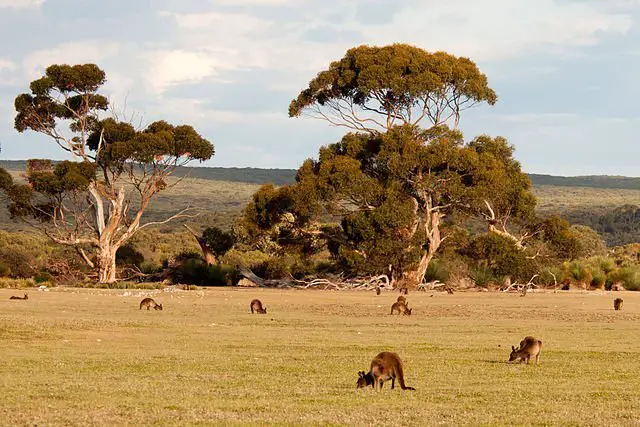
Where do kangaroos live in Australia – Where are kangaroos found
- Australia is the only country where kangaroos can be found in the wild.
- Kangaroos like to live in open grassy grounds away from the city.
- The area of New South Wales ‘Murramarang national park’ contains kangaroos.
- Kangaroos can also be found in ‘Bonorong Wildlife Sanctuary’ located outside of Hobart in Tasmania.
- Different species like Red, Gray, and different Wallabies species can be found in Currumbin Wildlife Sanctuary located on Queensland’s Gold Coast.
- Western grey kangaroos can be found on the Lucky bay on the western Australian coast.
- Kangaroo Island located on the coast of Adelaide, South Australia possesses some kangaroos.
- Kangaroo can be found easily in many places of Canberra, the capital city of Australia.
- Eastern gray kangaroos can be found in the Grampians National Park, Regional Victoria.
- Narawntapu National park, Tasmania possesses many wildlife animals including different species of kangaroos.
Why do kangaroos live in Australia?
- After Australia and Antarctica separated from each other. The animals on each sub-continent evolved differently.
- The animals in Australia evolved to marsupials while on other subcontinents the animals evolved to placental mammals.
- The animals moving between the continents could not survive due to harsh conditions.
Kangaroos can survive in various environments. So if a kangaroos’ mob is released anywhere on earth, they will survive most probably. - Other subcontinents have animals that might hunt kangaroos, so this might be the reason for no kangaroo outside Australia.
Do kangaroos live in the desert?
- Different species of kangaroo-like Red kangaroo can live in deserts as well.
- The basic problem living in the desert is the availability of water.
- Kangaroos can survive without water for many days.
- Hopping is an efficient way of conserving energy resources and water.
- Kangaroo hops conserve food and water. The water is reabsorbed in the intestine which conserves water.
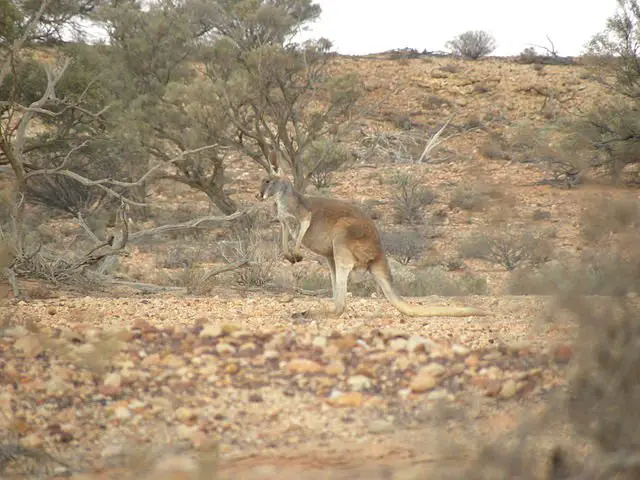
38. Where Do Kangaroos Come From
- Kangaroos are believed to living on Earth for more than four million years.
- Different theories exist regarding the origin of kangaroos. The theories discuss the kangaroos’ migration. Either they migrated from South America to Australia, or they have migrated from Australia to South America.
- The recent surveys prove that today’s kangaroo is the evolved form of the ‘Didelphimorphia’ (The Opossum).
- The ‘Didelphimorphia’ belonged to South America. So the kangaroo has migrated from South America. Didelphimorphia is believed to be the oldest marsupial.
39. How Many Kangaroos Live In Australia – Kangaroo Population
- The population of Kangaroo was 45 million in 2016.
- The population is on the growing trend. It was 27 million in 2010.
- The citizens of Australia are instructed to eat more kangaroo meat.
- Different states of Australia contain different populations of different species of kangaroos.
- South Australia has a Kangaroo population of about 2,327,600.
- Kangaroos have a population of more than 1,815,719 in Western Australia.
- The population of kangaroo in South Wales is more than 9,815,115.
- While Queensland contains more than 20,345,243 kangaroos.
- Red Kangaroos have a population of 11,514,298.
- Western grey kangaroos have a population of about 2,348,393.
- Eastern grey kangaroo has a population of about 16,057,783.
- Another species of kangaroo, Wallaroo has a population of about 4,383,203.
40. Types Of Kangaroos – Kangaroo Species
- There are four types of Kangaroos. These four Kangaroos species are:
- Red kangaroo
- Antilopine kangaroo
- Eastern grey kangaroo
- Western grey kangaroo.
- The red kangaroo is the largest species in kangaroos.
- Eastern grey kangaroo, which is also known as ‘great kangaroo’ is found in western and eastern parts of Australia.
- Western grey kangaroo which is also known as ‘Black-faced kangaroo’, ‘Mallee kangaroo’, and ‘Sooty Kangaroo’ is found in almost all parts of Australia.
- Antilopine kangaroo, also known as ‘Antilopine Wallaroo’ is found in Northern Australia.
- The larger species in the family ‘Macropodidae’ are called kangaroos and the smaller species are known as ‘Wallabies’.
Small Kangaroo Species
- Wallabies are regarded as small species of kangaroo.
- Kangaroo name is only given to larger species of the family ‘Macropodidae’,
- Wallabies also belong to the same species and sometimes the same genus.
- That’s why Wallabies are also considered as ‘kangaroos’ sometimes.
- Wallabies have a body size of about 45 to 105 cm. This size includes head and body length. The tail adds a length of 33 to 75 cm.
- They are found in Australia, New Zealand, and New Guinea.
41. Red kangaroo facts
- Red Kangaroo is the largest among the Marsupials.
- It is also considered the largest mammal in Australia.
- They have a height of two meters and a weight of 85 Kgs.
- The size of a male is bigger than the size of a female.
- They can attain a height of about 1.8 meters and a distance of 9 meters in a single jump.
- They can run at a speed of 64 kilometers when they sense danger.
- Their habitat includes grasslands, woodlands, and open forests.
- They are found in almost all parts of central Australia.
- They move in groups of about 10 kangaroos.
- They eat grasses and shrubs. They can live without water for many days.
42. Kangaroo Adaptations
- Kangaroos can live in almost all types of conditions. They can live in forests, semi-arid environments, and deserts.
- Their bodies need less amount of water. They can survive without water for many days. Their intestines re-absorbs water, and thus water is re-used resulting in dry feces.
- They are more active in the morning time, and nighttime when there the environment is not hot. This causes the conservation of energy and water.
- Kangaroos’ hopping is an efficient way of traveling. This also saves energy resources.
- Kangaroo pants when they are hot. They lick their chests and armpits to cool down their bodies.
- Female kangaroos can delay the gestation period and hence can prevent the birth of another child.
- They can produce different types of milk for their children. This way nutrient needs are fulfilled by the milk.
43. What Are Kangaroos Predators
- In the wild, Kangaroos fall prey to:
- The main predator of the kangaroo is a human being. Kangaroos are kept in farms for getting food (kangaroo meat).
- Many times kangaroos come on roads and are hit by vehicles.
44. Are Kangaroos Endangered – Kangaroo Endangered Status
- No, Kangaroos are not endangered. However, six species of the kangaroo family have been extinct since European settlement i.e after the 1780s.
- There are some species in the family ‘Macropodidae’ which are in danger. That species are killed for many purposes like getting fur.
- Looking into the history of kangaroo reveals that kangaroo’s population grows slowly and declines rapidly.
- A large number of kangaroos are killed for many purposes like leather, fur, meat, etc.
- No data can show that the kangaroos are in danger but we should not take it easy.
45. What Do Kangaroos Do
- Kangaroos live in groups known as ‘mob’, and ‘court’. In groups, the male kangaroos fight each other to get their favorite partner for mating. While fighting, the kangaroos stand on their hind legs and punch the opponent with the forelegs.
- Kangaroos are afraid of humans but when they are cornered or threatened, they prove very dangerous.
- When cars etc come on the way, the kangaroo is confused and comes in front of the car, causing road accidents.
- Kangaroos travel from one place to another by hopping. Hopping is an efficient way of locomotion.
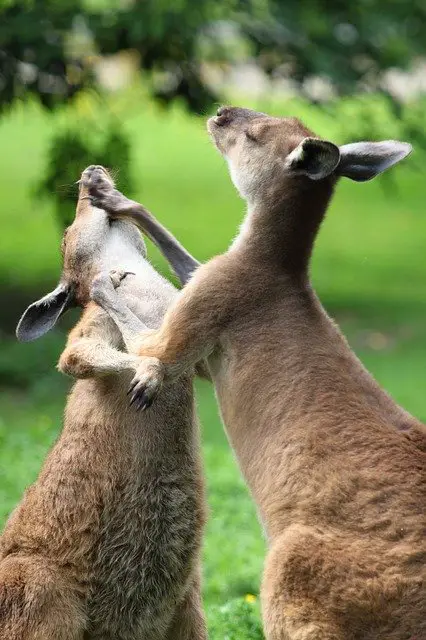
46. What Is A Group Of Kangaroos Called – Group Of Kangaroos
- A group of kangaroo is called ‘mob’, ‘troop’, or ‘court’. Kangaroos move in groups.
- The number of kangaroos in a mob can vary from 3, 4 to 100.
- Traveling in groups provides safety to the kangaroos.
47. Can Kangaroos Swim
- Yes, Kangaroos can swim.
- On land, the kangaroo can’t move their hind legs independently. But surprisingly, kangaroos move the hind legs in paddle movements while swimming.
- Kangaroos have been seen to swim in 20 feet deep water.
48. Is Kangaroo A Wild Animal
- Yes, Kangaroo is a wild animal.
- It can be kept in captivity as well. In a state in Australia and America, it is allowed to keep kangaroo as a pet. In other states, it is not allowed to be kept as a pet.
- Kangaroo can be dangerous to keep a pet. They are not suitable to keep in domestic areas as other domestic animals might catch diseases from them.
- In wild, kangaroo is free, goes for grass and food, and survives.
49. Are Kangaroos Mean
- Kangaroos can be dangerous as well when they are angry.
- Kangaroos can stand on the back feet and punch the opponent by the forefeet.
- Different species can be more or less dangerous depending upon their strength and body size.
- They can be more dangerous when they are threatened or cornered.
- People should not come nearer to kangaroos as they can start running which might result in accidents.
- However, kangaroos don’t go for finding troubles i.e they will not come to human beings for the attack, but scaring them can cause trouble.
- When nearer to the kangaroos you should not run from them, as they will assume you as another kangaroo, will chase you and fight you.
- Kangaroos fight with each other when they are in a group or mob. The stronger one gets the mate.
50. Interesting Facts About Kangaroos
- The name ‘kangaroo’ is used for the bigger species in the family ‘Macropodidae’. Their species are Red kangaroo, Western grey kangaroo, Eastern grey kangaroo, and Antilopine kangaroo.
- ‘Joey’ is a name given to small kangaroos.
- At the time of birth, the size of a kangaroo child is as small as the size of a bean.
- At the time of birth, the baby is very immature. They don’t possess any senses. The gestation period for a kangaroo is 30 days.
- A mother kangaroo can have different types of milk possessing different nutrients.
- One child is very small in the pouch, the other little bigger which stays outside the pouch but comes to the pouch for milk, and the female kangaroo has a waiting embryo as well which doesn’t come into the gestation cycle till the first child leave the pouch.
- The gestation period can be delayed as well with environmental conditions.
- Kangaroos are only found in Australia.
- The population of kangaroo in Australia is greater than the human population.
- Kangaroos live in groups. The number of kangaroos can vary from 3, 4 to 100 kangaroos.
51. Amazing Facts About Kangaroo
- Kangaroo is the largest mammal found in Australia.
- Kangaroos have pouches in the belly for keeping their babies.
- They have very muscular and powerful hind legs which help them in hopping.
- Kangaroos can hope to a height of 3 meters or 9.10 ft.
- They can cover a distance of 9 meters i.e 30 ft. in a jump.
- Kangaroos do crawl walking when going slow. In crawl walking, they use the hind legs, forelegs, and tail, or slow walking.
- The kangaroos left hind legs and ore legs separately.
- Kangaroos can grow to a height of 6.9 ft. with a weight of 90 Kgs.
- A female kangaroo can have 3 babies at a time, and she can provide different nutritional milk at a time depending upon the requirement of the babies.
- Kangaroos remain in groups and so they are protected from predators and other dangers.
- Kangaroo can do swimming where they can move their legs independently.
52. Weird Kangaroo Facts
- On land, kangaroos can’t move their forelegs and hind legs independently but in water, while swimming they can move their legs independently.
- Female kangaroos can produce different types of milk for their babies depending upon the needs of their babies.
- Male kangaroos show off to attain the attention of female kangaroos. Male with strong muscles get an easy partner for mating.
- It is believed that the name ‘kangaroo’ is arrived from ‘gangurru’ meaning ‘don’t know, but the study reveals that ‘gangurru’ is the name of a species.
- Kangaroo is differentiated from wallabies based on size only but actually, there are more differences as well like wallabies have brighter colors and have different teeth.
- Kangaroos have to cover large distances with less food and water. Hopping is an efficient way to do that. Kangaroos have strong hind legs and shorter forelegs which help them in hopping.
- When kangaroos see vehicles, they get confused and come in front of the vehicle causing accidents.
- If they feel any danger, they thump their feet to the ground to inform fellow kangaroos and warn the opponent or predator.


